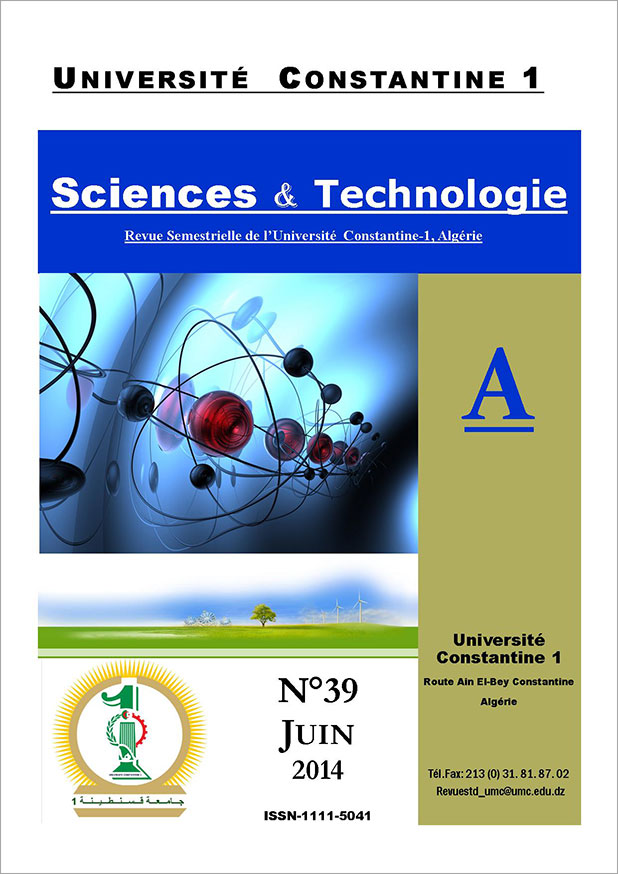PHOTODEGRADATION OF 3-(3,4- DICHLOROPHENYL)-1,1-DIMETHYLUREA IN PRESENCE OF NATURAL IRON OXIDE UNDER UV IRRADIATION
Keywords:
Photodegradation, Natural iron oxide, Linuron, Oxalic acid, Hydroxyl radicalsAbstract
Heterogeneous photodegradation of Linuron under UV irradiation was investigated. Natural iron oxide (NIO) was used in this study, to take a closer look at its adsorption capacity in the dark. The results obtained showed that the substrate photolysis is very slowly in artificial light (λ = 365nm). However, the introduction of oxalic acid (Ox) in the system improves the degradation process greatly. The dependence of Linuron degradation was attributed to the formation of the dissolved Fe-Ox in the solution and the adsorbed Fe-Ox on the surface of natural iron oxide. The effect of different parameters such as the oxalate concentration, pH and initial concentration of NIO on the photodegradation were studied in the iron oxide/ oxalate system. The results demonstrated that the optimal pH should be in the range of 2–3. The system efficiency is directly proportional to the concentration of polycarboxylate ions. The optimum mass of NIO used a good inducing disappearance of linuron was 1g.L-1. Furthermore, changes in the concentrations of Fe3+ and Fe2+ ions in the photo-reaction were also strongly dependent on the initial oxalate and iron oxide concentration. The use of 2% of isopropanol as a scavenger confirmed the intervention of hydroxyl radicals in the photodegradation of linuron.
Downloads
References
E.M. Thurman, “Organic Geochemistry of Natural Waters,” Martinus Nijhoff/Dr. W. Junk Publishers, 1985, p. p. 497.
E.M. Perdue, E.T. Gjessing (Eds.), Life Sciences Research Report 48: Organic acids in aquatic ecosystems. Report on the Dehlem Workshop on Organic Acids in Aquatic Ecosystems Berlin, 1989, May 7–12, 1990, 345.
R. W. Talbot, B. W. Mosher, B. G. Heikes, D. J. Jacob, J. W. Munger, B. C. Daube, W. C. Keene, J. R. Maben, and R. S. Artz, “Carboxylic acids in the rural continental atmosphere over the eastern United States during the Shenandoah Cloud and Photochemistry Experiment,” J. Geophys. Res. Atmospheres 1984–2012, vol. 100, no. D5, pp. 9335–9343, 1995.
A. Chebbi and P. Carlier, “Carboxylic acids in the troposphere, occurrence, sources, and sinks: A review,” Atmos. Environ., vol. 30, no. 24, pp. 4233–4249, 1996.
M.E. Balmer, B. Sulzberger, Environmental Science & Technology 33 (1999) 2418–2424.
Y.G. Zuo, J. Hoigne, Science 260 (1993) 71–73.”
Y.G. Zuo, J. Hoigne, Environmental Science & Technology 26 (1992) 1014–1022.
U. Schwertmann, R.M. Cornell, Iron Oxides in the Laboratory: Preparation and Characterization, second ed., Wiley–VCH, 2000.
“J.K. Leland, A.J. Bard, J. Phys. Chem. 91 (1981) 5076.).
Y.G. Zuo, Y.W. Deng, Chemosphere 35 (1997) 2051.”
B.C. Faust, J. Allen, Environ. Sci. Technol. 27 (1993) 2517.
D. Panias, M. Taxiarchou, I. Douni, I. Paspaliaris, and A. Kontopoulos, “Thermodynamic analysis of the reactions of iron oxides: Dissolution in oxalic acid,” Can. Metall. Q., vol. 35, no. 4, pp. 363–373, Oct. 1996.
B. Sulzberger, H. Laubscher, Marine Chemistry 50 (1995) 103–115.
R.M. Smith, A.E. Martell, Critical Stability Constants, vols. 2–3: Inorganic Complexes/Other Organic Ligands, Plenum Press, New York, 1976.
Q.G. Mulazzani, J. Phys. Chem. 90 (1986) 5347.
P. Mazellier, B. Sulzberger, Environmental Science & Technology 35 (2001) 3314–3320.
Q. Lan, F.B. Li, C.S. Liu, X.Z. Li, Environmental Science & Technology 42 (2008) 7918–7923.
M. I. Litter, E.C. Baumgartner, G.A. Urrutla, M.A. Blesa, Environmental Science & Technology 25 (1991) 1907–1913.
USEPA, Reregistration Eligibility Decision (RED), Linuron, (EPA/NCEPI), 1995.
O. Cincinnati, “NEPIS Document display.
British Crop Protection Council, The pesticide manual: a world compendium, 11th ed. Farnham, Surrey, UK: British Crop Protection Council, 1997.
V. Faure and P. Boule, “Phototransformation of linuron and chlorbromuron in aqueous solution,” Pestic. Sci., vol. 51, no. 4, pp. 413–418, Dec. 1997.
F. J. Benitez, F. J. Real, J. L. Acero, and C. Garcia, “Photochemical oxidation processes for the elimination of phenyl-urea herbicides in waters,” J. Hazard. Mater., vol. 138, no. 2, pp. 278–287, Nov. 2006.
H. Barlas, Treatment of chlorinated organic materials containing wastewater by oxidation processes, Fresenius Environ. Bull. 9 (2000) 590–596.
F. J. Benitez, F. J. Real, J. L. Acero, and C. Garcia, “Kinetics of the transformation of phenyl-urea herbicides during ozonation of natural waters: Rate constants and model predictions,” Water Res., vol. 41, no. 18, pp. 4073–4084, 2007.
Y. F. Rao and W. Chu, “Reaction mechanism of linuron degradation in TiO2 suspension under visible light irradiation with the assistance of H2O2,” Environ. Sci. Technol., vol. 43, no. 16, pp. 6183–6189, 2009.
Y. F. Rao and W. Chu, “Degradation of linuron by UV, ozonation, and UV/O3 processes—Effect of anions and reaction mechanism,” J. Hazard. Mater., vol. 180, no. 1–3, pp. 514–523, Aug. 2010.
R. Rosal et al. / Chemical Engineering Journal 165 (2010) 806–812.
L. Amir Tahmasseb, S. Nélieu, L. Kerhoas, and J. Einhorn, “Ozonation of chlorophenylurea pesticides in water: reaction monitoring and degradation pathways,” Sci. Total Environ., vol. 291, no. 1–3, pp. 33–44, May 2002.
H. Katsumata, S. Kaneco, T. Suzuki, K. Ohta, and Y. Yobiko, “Degradation of linuron in aqueous solution by the photo-Fenton reaction,” Chem. Eng. J., vol. 108, no. 3, pp. 269–276, 2005.
M. J. Farré, X. Doménech, and J. Peral, “Assessment of photo-Fenton and biological treatment coupling for Diuron and Linuron removal from water,” Water Res., vol. 40, no. 13, pp. 2533–2540, 2006.
M. J. Farré, X. Doménech, and J. Peral, “Combined photo-Fenton and biological treatment for Diuron and Linuron removal from water containing humic acid,” J. Hazard. Mater., vol. 147, no. 1–2, pp. 167–174, Aug. 2007.
M. J. Farré, M. I. Maldonado, W. Gernjak, I. Oller, S. Malato, X. Domènech, and J. Peral, “Coupled solar photo-Fenton and biological treatment for the degradation of diuron and linuron herbicides at pilot scale,” Chemosphere, vol. 72, no. 4, pp. 622–629, Jun. 2008.
H. Katsumata, T. Kobayashi, S. Kaneco, T. Suzuki, and K. Ohta, “Degradation of linuron by ultrasound combined with photo-Fenton treatment,” Chem. Eng. J., vol. 166, no. 2, pp. 468–473, Jan. 2011.
M.C. Lopez, M.I et al. 2005.
R. Zouaghi, A. Zertal, B. David, and S. Guittonneau, “Photocatalytic degradation of monolinuron and linuron in an aqueous suspension of titanium dioxide under simulated solar irradiation,” Rev. Sci. EauJournal Water Sci., vol. 20, no. 2, pp. 163–172, 2007.
Y. F. Rao and W. Chu, “Linuron decomposition in aqueous semiconductor suspension under visible light irradiation with and without H2O2,” Chem. Eng. J., vol. 158, no. 2, pp. 181–187, Apr. 2010.
J. Fenoll, M. Martínez-Menchón, G. Navarro, N. Vela, and S. Navarro, “Photocatalytic degradation of substituted phenylurea herbicides in aqueous semiconductor suspensions exposed to solar energy,” Chemosphere, vol. 91, no. 5, pp. 571–578, Apr. 2013.
F. Gulshan, S. Yanagida, Y. Kameshima, T. Isobe, A. Nakajima, and K. Okada, “Various factors affecting photodecomposition of methylene blue by iron-oxides in an oxalate solution,” Water Res., vol. 44, no. 9, pp. 2876–2884, 2010.
J. Lei et al. / Journal of Hazardous Materials B137 (2006) 1016–1024.
T. Zhou, X. Wu, Y. Zhang, J. Li, and T.-T. Lim, “Synergistic catalytic degradation of antibiotic sulfamethazine in a heterogeneous sonophotolytic goethite/oxalate Fenton-like system,” Appl. Catal. B Environ., vol. 136–137, pp. 294–301, Jun. 2013.
F. B. Li, X. Z. Li, X. M. Li, T. X. Liu, and J. Dong, “Heterogeneous photodegradation of bisphenol A with iron oxides and oxalate in aqueous solution,” J. Colloid Interface Sci., vol. 311, no. 2, pp. 481–490, Jul. 2007.
S. Belaidi, T. Sehili, L. Mammeri, and K. Djebbar, “Photodegradation kinetics of 2,6-dimetylphenol by natural iron oxide and oxalate in aqueous solution,” J. Photochem. Photobiol. Chem., vol. 237, pp. 31–37, Jun. 2012.
L. Mammeri, T. Sehili, S. Belaidi, and K. Djebbar, “Heterogeneous photodegradation of 1-naphthol with natural iron oxide in water: influence of oxalic acid,” Desalination Water Treat., no. ahead-of-print, pp. 1–10, 2014.
Sedlak, D.L., Hoigne, J., 1993. The role of copper and oxalate in the redox cycling of iron in atmospheric waters. Atmos. Environ. 27, 2173–2185.
L. Lunar, D. Sicilia, S. Rbio, D. Perez-Bendito, U. Nickel, Water Research 34 (2000) 1791.







